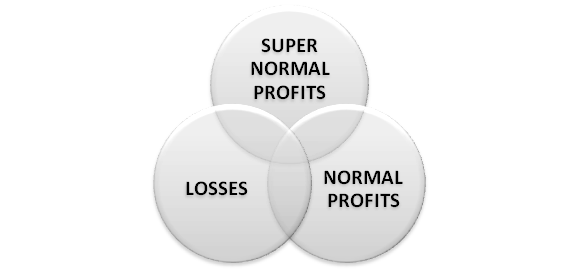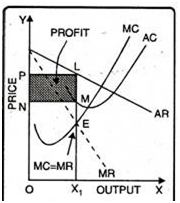MONOPOLISTIC COMPETITION
The concept of monopolistic competition was put-forth by an American economist Prof. E.H. Chamberlin in his popular book, “The Theory of Monopolistic Competition” published in 1933.
Monopolistic competition is a type of imperfect competition market structure in which a large number of firms produce differentiated products and there are no barriers to entry.
ACCORDING TO LIM CHONG YHA
“Monopolistic competition is a market situation where there are many producers but each offers a slightly differentiated product.”
ACCORDING TO JOE S BAIN
“Monopolistic competition is found in the industry where there are a large number of small sellers selling differentiated but close substitute products.”
ACCORDING TO LEFTWITCH
“Monopolistic competition is a market situation in which there are many sellers of a particular product, but the product of each seller is in some way differentiated in the minds of consumers from the product of every other seller.”
ACCORDING TO PROF HH LEIBHAFSKY
‘Monopolistic competition has today come to mean a state of affairs in which there is a large number of sellers selling non-homogenous or slightly differentiated products and in which freedom of entry exists.‘
Markets which exhibit monopolistic competition include restaurants, hospitals, small retail outlets, etc.
FEATURES OF MONOPOLISTIC COMPETITION
The main features of monopolistic competition are as under:
LARGE NUMBER OF BUYERS AND SELLERS
There are large number of firms but not as large as under perfect competition.
That means each firm can control its price-output policy to some extent. It is assumed that any price-output policy of a firm will not get reaction from other firms that means each firm follows the independent price policy.
If a firm reduces its price, the gains in sales will be slightly spread over many of its rivals so that the extent to which each of the rival firms suffers will be very small. Thus these rival firms will have no reason to react.
FREE ENTRY AND EXIT OF FIRMS
Like perfect competition, under monopolistic competition also, the firms can enter or exit freely. The firms will enter when the existing firms are making super-normal profits. With the entry of new firms, the supply would increase which would reduce the price and hence the existing firms will be left only with normal profits. Similarly, if the existing firms are sustaining losses, some of the marginal firms will exit. It will reduce the supply due to which price would rise and the existing firms will be left only with normal profit.
PRODUCT DIFFERENTIATION
Another feature of the monopolistic competition is the product differentiation. Product differentiation refers to a situation when the buyers of the product differentiate the product with other. Basically, the products of different firms are not altogether different; they are slightly different from others. Although each firm producing differentiated product has the monopoly of its own product, yet he has to face the competition. This product differentiation may be real or imaginary. Real differences are like design, material used, skill etc. whereas imaginary differences are through advertising, trade mark and so on.
LACK OF PERFECT KNOWLEDGE
The buyers and sellers do not have perfect knowledge of the market. There are innumerable products each being a close substitute of the other. The buyers do not know about all these products, their qualities and prices.
Therefore, so many buyers purchase a product out of a few varieties which are offered for sale near the home. Sometimes a buyer knows about a particular commodity where it is available at low price. But he is unable to go there due to lack of time or he is too lethargic to go or he is unable to find proper conveyance. Likewise, the seller does not know the exact preference of buyers and is, therefore, unable to get advantage out of the situation.
LESS MOBILITY
Under monopolistic competition both the factors of production as well as goods and services are not perfectly mobile.
INDEPENDENT PRICE POLICY AND DOWNWARD SLOPING OF AR-MR CURVES
A firm under monopolistic competition can have an independent price policy. It is price maker for its product. Hence the AR and MR curves facing a firm under monopolistic competition will be downward sloping similar to the monopoly.
But there is an important difference between the AR curves under monopoly and monopolistic competition. The AR curve under monopolistic competition is somewhat flatter than in the monopoly.
AR and MR curves of a firm under monopolistic competition are illustrated in the diagram:

Under monopolistic competition, demand curve is more elastic. In order to sell more, the firms must reduce its price.
SOME CONTROL OVER PRICE
Since, the products are close substitutes for each other, if a firm lowers the price of its product, then the customers of other products will switch over to it. Conversely, with the increase in the price of the product, it will lose its customers to others. Thus, under the monopolistic competition, an individual firm is not a price taker but has some influence over the price of its product.
HEAVY EXPENDITURE ON ADVERTISEMENT AND OTHER SELLING COSTS
Under the monopolistic competition, the firms incur a huge cost on advertisements and other selling costs to promote the sale of their products. Since the products are different and are close substitutes for each other; the firms need to undertake the promotional activities to capture a larger market share.
EQUILIBRIUM/ PRICE AND OUTPUT DETERMINATION UNDER MONOPOLISTIC COMPETITION
A firm is said to be in equilibrium when it is incurring minimum costs and gaining maximum profits. Under monopolistic competition, the equilibrium is ascertained differently for industry and firm.
EQUILIBRIUM/ PRICE AND OUTPUT DETERMINATION FOR FIRM
For a firm, the equilibrium may be determined in both long run and short run.
SHORT RUN EQUILIBRIUM
Under monopolistic competition, the firm will be in equilibrium position when marginal revenue is equal to marginal cost. So long the marginal revenue is greater than marginal cost, the seller will find it profitable to expand his output, and if the MR is less than MC, it is obvious he will reduce his output where the MR is equal to MC.
CONDITIONS: The two conditions to be satisfied for the firm to be in equilibrium are as follows:
(1) MC = MR
(2) MC must cut MR from below.
Under monopolistic competition also, a firm will make the maximum profits when these two conditions are satisfied.
The firm may face any of three situations:

SUPER NORMAL PROFIT
Under monopolistic competition, a firm earns maximum profits or is in equilibrium when MC=MR and MC cuts MR from below. In the diagram the firm is in equilibrium at OX level of output and at the point E, at which MR and MC are equal and MC cuts MR from below.

The firm is earning super-normal profits or abnormal profits since average revenue is greater than average cost, i.e., AR > AC. The main reason for these abnormal profits is that, the other rival firms are not able to produce closely competitive substitutes. Hence, they are not able to attract consumers towards their product.
NORMAL PROFIT
If under monopolistic competition, the price of product is equal to AC, the firm will be earning normal profit. In Figure MC is equal to MR at point E. This is the equilibrium point. At equilibrium point, the equilibrium output is OX1 and price is OP1. At this point, AC is NX1 and AR is also NX1 i.e., AC=AR. Thus the firm will be earning only normal profits.

SUSTAINING LOSSES
It is also possible that the demand may not be favourable to firm under monopolistic competition, i.e., it may not be able to attract the consumers towards its product, if it fixes price equal to its SAC. But it is compelled to sell its product at the price which is less than even its short period average cost.

Hence, it may incur losses such firm, in the long-run may leave the industry, if it is not possible for it to change its demand relative to its cost conditions through product differentiation and advertisement. In figure the firm is in equilibrium at point E, where MC=MR. At this equilibrium level the output is OX1 at price OP. Corresponding to this, the average cost LX1 is greater than average revenue MX1, Since, revenue is less than cost, the firm will sustain losses equal to the shaded area PLMN.
LONG RUN EQUILIBRIUM
Long period refers to that time period in which each firm can change its production capacity by changing the fixed as well as variable factors. New firms can enter the industry and old firms can exit it. Basically, the firms in the long run will get the normal profits.

If, the existing firms are making super normal profits, it will attract some of the new firms in the industry. The entry of new firms will result into over production which will have a depressing effect on price. Hence all the firms in the long run will get normal profits. In figure output is measured on X-axis whereas price on Y-axis. LAC is the long run average cost and LMC is the long fun marginal cost curve. The firm is in equilibrium because at point E, MC = MR. The equilibrium output is OX1 and price is OP. Since, at this equilibrium average revenue curve is tangent to long run average cost curve at point M; hence the firms are earning normal profits.
EQUILIBRIUM/ PRICE AND OUTPUT DETERMINATION FOR INDUSTRY
Under monopolistic competition, the word ‘group’ is used for industry. There is a difference between an industry and a group. An industry generally consists of firms which produce homogeneous product, whereas a group is composed of firms which produce a differentiated product. Thus group consists of a number of firms producing close substitutes. For example, shoe making firms like ‘Bata’, ‘Carona’, and ‘Liberty’ are a group.
Assumptions of equilibrium of industry:
(i) Demand and cost curves of all the firms are identical,
(ii) No firm can influence the price and output decisions of its rivals.
The Group Equilibrium is shown below with the help of following figure:

In the diagram, DD1 is the group demand curve and CC is the cost curve. Every firm would like to fix up OP price because at this price the difference between price and cost is the maximum and producer gets supernormal profit equal to PMTB. The other firms will be attracted to enter the market and now the market demand will be shared by a larger number of firms. In this situation demand curve will shift downwards and the new demand curve will be DD2.
The number of firms in the market will continue increasing till the new demand curve DD2 is tangent to the cost curve. In the Figure, at point ‘K’ demand curve is tangent to the cost curve. At this point firm will be earning only normal profit and this will be the equilibrium position of the firm. Thus under monopolistic competition, OB is the equilibrium price and ON is the equilibrium output.
